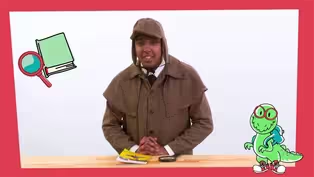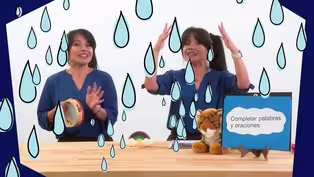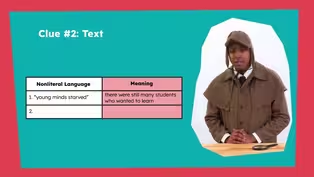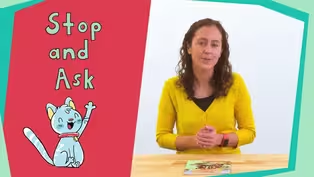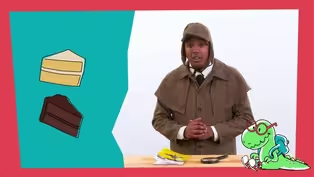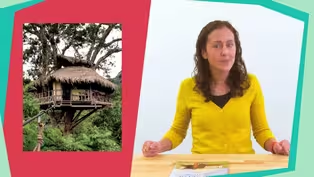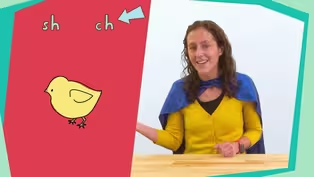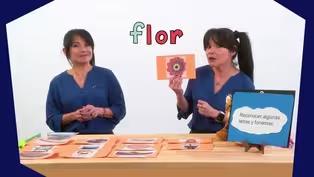
Episode 19 | Literacy Lessons
3/30/2021 | 28m 46sVideo has Closed Captions
Literacy lessons for early learners, led by NC teachers.
The first lesson (aimed at PreK-K learners) helps early learners understand concepts of print, and identify colors. The second lesson (aimed at 1st-2nd graders) helps students determine meanings of words based on word parts. Classroom Connection is your At-Home Learning companion where children love to learn. All lessons are led by NC educators.
Problems playing video? | Closed Captioning Feedback
Problems playing video? | Closed Captioning Feedback
At-Home Learning Presents: Classroom Connection is a local public television program presented by PBS NC

Episode 19 | Literacy Lessons
3/30/2021 | 28m 46sVideo has Closed Captions
The first lesson (aimed at PreK-K learners) helps early learners understand concepts of print, and identify colors. The second lesson (aimed at 1st-2nd graders) helps students determine meanings of words based on word parts. Classroom Connection is your At-Home Learning companion where children love to learn. All lessons are led by NC educators.
Problems playing video? | Closed Captioning Feedback
How to Watch At-Home Learning Presents: Classroom Connection
At-Home Learning Presents: Classroom Connection is available to stream on pbs.org and the free PBS App, available on iPhone, Apple TV, Android TV, Android smartphones, Amazon Fire TV, Amazon Fire Tablet, Roku, Samsung Smart TV, and Vizio.
Providing Support for PBS.org
Learn Moreabout PBS online sponsorshipMore from This Collection
Video has Closed Captions
Literacy lessons for early learners, led by NC teachers. (28m 46s)
Video has Closed Captions
Literacy lessons for early learners, led by NC teachers. (28m 46s)
Video has Closed Captions
Literacy lessons for early learners, led by NC teachers. (28m 45s)
Video has Closed Captions
Literacy lessons for early learners, led by NC teachers. (28m 45s)
Video has Closed Captions
Literacy lessons for early learners, led by NC teachers. (28m 46s)
Video has Closed Captions
Literacy lessons for early learners, led by NC teachers. (28m 46s)
Video has Closed Captions
Literacy lessons for early learners, led by NC teachers. (28m 45s)
Video has Closed Captions
Short Description: Literacy lessons for early learners, led by NC teachers. (28m 45s)
Video has Closed Captions
Literacy lessons for early learners, led by NC teachers. (28m 45s)
Video has Closed Captions
Literacy lessons for early learners, led by NC teachers. (28m 45s)
Video has Closed Captions
Literacy lessons for early learners, led by NC teachers. (28m 45s)
Video has Closed Captions
Literacy lessons for early learners, led by NC teachers. (28m 45s)
Providing Support for PBS.org
Learn Moreabout PBS online sponsorship[cheerful upbeat music] ♪ - What's good, my good people?
I'm Mr. R, and I'm gonna be your guide on today's learning journey.
There's gonna be some twists and some turns, but mostly we're gonna have some fun.
- Hello, super learners.
My name is Mrs. Jennifer, and I am so excited that you are here to learn with me today.
You will need crayons and a stuffed animal for today's lesson.
Ask a trusted adult to help you find these items.
While you're getting your supplies, I'm gonna grab mine as well.
I'll be right back.
[upbeat music] Okay, I'm back now, and I see you are too.
We have our supplies, super learners, so let's get started.
Today we are going to be learning about reading words from left to right, the parts of a book, and what the author and illustrator do.
We will also read a story about a butterfly that really likes flowers.
Are you ready?
Great.
Let's go.
This is our story for today.
It is titled "Butterfly."
Do you remember what a title is?
Tell your stuffed friend.
Right.
The title is the name of the book.
Now we'll learn some new words.
The author of this story is Jephson Gibbs.
He wrote the words that we will read.
The author writes the words.
Say that with me, the author writes the words.
Tell your stuffed friend.
[gentle upbeat music] Now that we know that the author writes the words, let's learn about the illustrator.
This book is illustrated by Molly Floss.
She drew the pictures that we will see.
The illustrator draws pictures.
Say that with me, the illustrator draws pictures.
Tell your stuffed friend.
It's important to know what authors and illustrators do so we can talk about their words and pictures when reading a book.
One strategy that helps me remember important ideas is to make up a rhyme about them.
Here is a rhyme that you can use to help you remember what the author and illustrator do.
"The author is the person who writes the book.
The illustrator draws so we can look."
Now say it with me.
"The author is the person who writes the book.
The illustrator draws so we can look."
Again.
[gentle music] "The author is the person who writes the book.
The illustrator draws so we can look."
Great job, friends.
[air whooshing] Let's look again at our book to see how the author and illustrator are included to identify other important parts of a book.
When we look at the front cover, we can see the title "Butterfly," the author's name, Jephson Gibbs, and the illustrator's name, Molly Floss, and a picture of what the story is going to be about.
This part of the book is called the back cover.
The front and the back covers work together to keep the pages safe.
This part is the spine.
It holds the pages together.
Now when we read, it is very important that we read from left to right.
I'll explain why in another part of this lesson.
Right now, let's go back to the front cover and use the illustration to make some predictions about what our book is gonna be about.
A prediction is a guess we make based on what we already know.
When we look at the picture on the front, what are some things we see?
[gentle music continues] That's right, we see a butterfly, some flowers, and lots of different colors.
I wonder why Butterfly is near all these flowers?
Why do you think Butterfly is near the flowers?
Tell your stuffed friend what you think.
I heard some great ideas, like maybe she is eating the flowers, or maybe she likes the colors.
To find out why Butterfly is near the flowers, let's start reading the book.
When we open our book the first page we come to is called the title page.
Do you remember why it is called the title page?
That's right, it has the title on it.
Let's turn the page and find out why Butterfly is near all of these flowers.
I'm gonna put my finger on this first word, and I'm going to read from left to right the words that the author has written.
"Butterfly likes yellow flowers."
We can see in the picture the illustrator drew that Butterfly has landed on some yellow flowers.
Can you show your stuffed friend your yellow crayon?
Here's mine.
[gentle playful music] The words the author wrote and the picture the illustrator drew work together to help us understand the story.
If you are just learning your colors, then these pictures that the illustrator drew are very important to helping you learn what each color looks like.
After you learn how to read, you will look at the words and know what the author says.
"Butterfly likes white flowers."
Let's look at the picture the illustrator drew.
What color flowers has Butterfly landed on?
That's right, white flowers.
Can you show your stuffed friend your white crayon?
Did your white crayon look like this?
"Butterfly likes red flowers."
Let's look at the picture the illustrator drew.
What color flowers has Butterfly landed on?
That's right, red flowers.
Can you show your stuffed animal your red crayon?
Here's mine.
"Butterfly likes pink flowers."
Let's look at the picture the illustrator drew.
What color flowers has Butterfly landed on?
That's right, pink flowers.
Can you show your stuffed friend your pink crayon?
Your pink crayon should look like this.
[gentle playful music continues] "Butterfly likes orange flowers."
Let's look at the picture that the illustrator drew.
What color flowers has Butterfly landed on?
That's right, orange flowers.
Can you show your stuffed friend your orange crayon?
Great.
Here's mine.
"Butterfly likes purple flowers."
Let's look at the picture the illustrator drew.
What color flowers has Butterfly landed on?
That's right, purple flowers.
Can you show your stuffed friend your purple crayon?
Your purple crayon should look something like this.
"Butterfly likes flowers."
Do you like flowers?
You might not like them very much if you have allergies.
Ahchoo!
They might make you sneeze.
But I like flowers, they smell so good.
Did you notice while I was reading that I started reading on the left and went to the right.
I did that because as super learners, we always read from left to right.
If I didn't read that way, then when I started the story, it would have read like this.
"Flowers yellow likes Butterfly."
Does that make sense?
Would we be able to understand the story if I didn't read it from left to right?
No way!
That doesn't make sense.
So, super learners, which way do we read and write?
You got it!
Left to right.
Remember how earlier in the lesson I told you about a rhyming strategy that I use to remember important things?
Well, I'm gonna use another rhyme to help me remember how to read and write.
Now give me just a minute, while I change this chant and put up our new one.
So I'm gonna take this one down.
[gentle playful music continues] And I'm gonna put the new one up.
All right, super learners.
[air whooshing] Let's get ready to read our new chant to help us remember how to read and write, and it goes like this.
"Top to bottom and left to right.
That's the way we read and write."
Great job.
Now say it one more time.
"Top to bottom and left to right.
That's the way we read and write."
Again, "Top to bottom, left to right.
That's the way we read and write."
One more time, friends.
"Top to bottom and left to right.
That's the way we read and write."
All right, super learners.
That is the end of our lesson for today.
Thank you so much for being with me as we learned about reading words from left to right, the parts of a book and what the author and illustrator do.
I hope you enjoyed "Butterfly" and all of the colorful flowers.
See you next time.
[air whooshing] - I love that lesson.
Our teachers are such important people and we're so grateful for them.
If you see a teacher today, say thank you for all that they do to help us grow.
- Hi, friends, it's Ms. B.
[gentle music] I'm so excited to move with you today.
We're going to do our sunrise stretches.
Before we get started, turn our bodies forward, inhale, our arms up towards the sky, sending our fingertips up towards the sun, maybe even wiggling them just a little bit.
And then we'll send our arms out like wings.
We'll breathe all our breath out.
Fold our bodies forwards, bending our fingertips, wiggling towards the Earth.
Take one big breath in.
[inhales deeply] Let it all go.
[exhales deeply] Bend your knees, open your arms like wings and send them back up towards the sky.
And then arms by your side.
We'll do that two more times.
Are you ready?
Let's do it.
Inhale, those fingertips up towards the sky.
Open your arms like wings and fold your body forward, letting all your breath out.
Your fingertips are wiggling towards the Earth.
Take a big breath in.
[inhales deeply] Let it all go.
[exhales deeply] Bend your knees, open your arms like wings and send those fingertips back up towards the sky.
We have one more to do.
Arms back by your side.
Inhale, send those fingertips up towards the sky.
Open your arms like wings, fold your body forward.
Let your big breath out.
[exhales deeply] Fingertips wiggling towards the Earth.
Take a nice big breath in.
[inhales deeply] Let it all out.
[exhales deeply] Bend those knees, open your arms like wings and send your fingertips back up towards the sky.
Bring your palms together, down to your heart.
And that's it with our sunrise stretch.
That was so much fun.
I can't wait to do it with you again.
Until next time, bye, friends.
[upbeat music] - Hello readers, my name is Ms. Gary, and I'm so excited to be learning with you today.
Before we get started with our lesson, let's say hello with our welcome song.
You ready?
♪ Hello readers, hello readers ♪ ♪ How are you, how are you ♪ ♪ I'm so glad to see you ♪ ♪ I'm so glad to teach you ♪ ♪ Hello, you ♪ ♪ You and you ♪ [gentle upbeat music] Readers, do you know what the word vocabulary means?
Well, vocabulary is a collection of words and their meanings.
Why do you think it's important for us to learn new words?
Think about that for a second.
Now whisper your answer to me.
Why is it important to learn new words?
I'll listen.
Those were amazing answers.
Learning new words makes us even smarter.
But when we know a lot of words, it gives us lots of choices to use when we're writing and speaking.
And it helps you when you're reading to better understand the text.
To do this, we're going to create a Frayer Organizer.
What you're going to need is three pieces of paper and something to write with.
So I'm gonna grab my paper and you go grab yours.
I'll be right back.
[air whooshing] [upbeat music] Okay, readers, I'm back with my three pieces of paper and something to write with.
I grabbed a pen, but you can write with whatever you like.
So to get us started, the first thing we're going to do is stack our papers just like this.
[gentle upbeat music] Then we're going to fold our paper both the long way and the short way.
So we'll fold it in half like this.
And then we'll fold it the long way, like this.
You're going to end up with a piece of paper that has four different sections.
So what you're going to do now is you can draw a big line right down the crease where your paper's folded, like this.
And across the long way where the other crease is, just like this.
[gentle music] This is what makes our Frayer Model Organizer.
Let's get ready to put some words in our Frayer Model.
The graphic organizer is going to help us stay organized while we learn all these new words.
It's gonna be where we record the word, the definition, use a sentence, and put a picture there.
So since we're working with vocabulary development today, let's write the word word, in our first box on the upper left-hand.
Just like this.
Word.
Good.
Make sure you have enough space to write your word.
Now, in the next box, we're going to write the word sentence.
It's going to be in our lower left-hand box.
And that's where we'll write our sentence to go with our word, just like this.
And I have two boxes left.
On the top box of my right side, I'm gonna write the word define.
And that's where I'll put the meaning for all of the words that I learn today.
Right there.
And in our final box we're going to write the word draw or picture, because that's where we'll put our picture to help us better understand what the words mean.
So this is what your Frayer Model will look like.
[gentle upbeat music] So readers, now that you've made your own graphic organizers, we're going to get ready to hear our first word for today.
So our first word, are you ready?
It's the word similar.
Have you ever heard the word similar before?
Maybe your teachers have used it or someone that you love.
So let's write the word similar in our top box that says word.
Write similar, just like I did.
Great, now you're going to listen to me use the word similar in a sentence.
[air whooshing] "The girl and her friend had on similar shirts."
So let's add that sentence to our sentence portion of our graphic organizer.
What do you think the word similar means, now that you've heard me use it in a sentence?
Hmm.
Think about it.
[light upbeat music] Well, similar means to have qualities in common, or be alike, or the same.
So in my define section of my Frayer Model, I'm going to write that definition down so that I always remember what the word similar means.
So go ahead and write down your definition of similar.
To have qualities in common or be the same or different.
Our final box is our picture box, and that's where you put a picture that helps you remember what the word means.
So my sentence says that the girls had on similar shirts and we know that similar means same.
So I'm gonna draw two pictures of a shirt so that I remember it means the same.
And I'm even gonna put some stripes on mine.
So that way, when I see or hear the word similar, I know that it means the same.
This will help me figure out that word.
So now that we know what the word similar means, I want you to think about what the word dissimilar means.
Listen to me use this in a sentence.
"The two shirts were dissimilar."
Hmm, I'm gonna share my thinking.
When I add a prefix like dis to a word, it means not.
So if dis means not, and similar means the same or alike, then dissimilar will mean not alike or not the same.
Can you think of a motion to help you remember the word similar?
Let me see it, and then I'll show you mine.
Here's mine.
Similar.
Two and two are the same.
So, wonderful job.
And you even filled out your Frayer Model with me to help you stay organized with learning your new vocabulary words.
So here's our next word.
Our next word, readers, is amused.
Can you write the word amused in the word section of your Frayer Model Organizer?
Right there.
Awesome job.
That's the word amused.
So I'm going to use the word amused, that we just heard, in a sentence, and you're going to figure out what do you think this means?
Are you ready?
[air whooshing] "I was amused by the clowns at the circus."
Hmm, take a moment and write that sentence down and think about what it means.
"I was amused by the clowns at the circus."
When we write the sentence down, it helps us to have a deeper understanding of our vocabulary word.
So think about how I used that word in my sentence.
What do you think it means?
I'm gonna share my thinking and record the definition of the word amused.
So amuse is the base word for amused, and it means to find something funny.
When I added the D to the end of my word amused, it changed it to the past tense.
So if the clowns amused me, that means they entertained me.
And let's say I added the prefix un to the beginning of my word amused.
And I was unamused by the clowns at the circus.
If I know that un means not, but amused means to entertain me, then that means the clowns did not entertain me.
So now write the definition to find something funny in the defined portion.
And you can also draw a picture to go with it.
Like maybe you draw an emoji that's laughing to help you remember what the word amused means.
You can also think about a motion to go with the word, and that really helps your understanding.
So look at my motion.
[laughs] That was funny.
I pretended to laugh.
I fake laughed, which means I was amused.
That'll help you remember.
So now let's learn our next word.
[gentle upbeat music] Our next word is the word disappear.
So it's your turn to write the word disappear in your Frayer Model Organizer.
Hmm, let's listen to me use the word disappear in our sentence.
Think about what it means.
[air whooshing] "He watched the fox disappear into the tall grass."
Add that sentence, and think about what the word disappear means.
So first, let's look at our word again.
Disappear.
The word appear in disappear means to be seen.
But when I added the dis or the prefix to the word disappear, it means not.
So if dis means not, and appear means seen, then disappear will mean... Tell me.
You got it right!
It means to not be seen.
Can you think of a picture to draw to help you remember the word disappear, which means to not be seen?
That's a good drawing.
You can also add a motion to it.
Like, look at mine.
If you can't see me because I disappear, that will help you remember the word also.
So now let's look at our next word.
[gentle upbeat music continues] Our next word is the word known.
Go ahead and write that down in the upper left-hand corner of your Frayer Model.
Known.
How am I gonna figure this out?
Listen to me read the sentence and see what you think it means.
"I have known my friend for 10 years."
Copy that down and think about what does the word known mean?
Hmm, I've known them for 10 years.
So that means that I must be familiar with them or recognize them.
So when I see the word known, I know that it will mean to be familiar with, or recognize.
What can you draw to help you remember what the word known means?
I could draw two friends because they maybe have known each other for a long time.
[gentle music] So if I know that my word known means familiar or recognize, do you remember the prefix un that means not?
If I put that in front of my word known, do you know what the meaning of the word unknown would be?
[air whooshing] That's right.
It would mean not familiar.
And so that would teach me another word.
What would your motion be for unknown or known?
That was great, readers.
[air whooshing] So learning the meaning of words is important because it helps you to build a better knowledge of your words, but it also gives us a lot of options for our word choice.
So you all have been great today, and I thank you so much for joining me as we learned about the importance of using vocabulary words.
Remember that words are everywhere around us, and the more words that we know, the more choices that we have to use them.
So take the time to make your own Frayer Models like we did today.
I had a great time teaching you today.
So until next time, I'll see you later, readers.
[air whooshing] [gentle upbeat music] - That was another great lesson.
You know what would be really cool?
To take all the reading and writing practice and write a thank you note to someone who did something nice for you.
My friend just sent me a note in the mail and it was so nice to get something in the mail.
What a fun surprise.
[cheerful upbeat music] ♪
Support for PBS provided by:
At-Home Learning Presents: Classroom Connection is a local public television program presented by PBS NC
